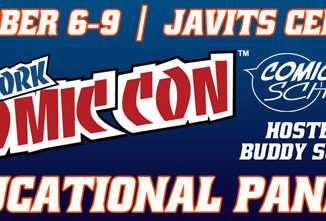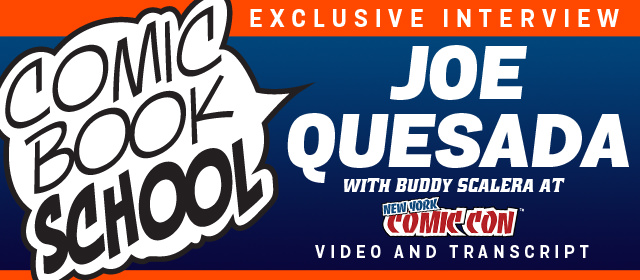
On Friday, October 7, 2016, I interviewed Joe Quesada, the Chief Creative Officer for Marvel Comics at New York Comicon 2016. This long-form interview format allowed us to explore different aspect’s of Joe’s amazing career.
If you make comics, you’ll find this to be an educational and inspiring conversation.
Special thanks to Nelson DeCastro for capturing this moment on video.
Full Transcript from the Video with Joe Quesada
>> BUDDY SCALERA: So 20+ years ago I was a kid breaking into comic books as a journalist. I had a journalism degree and the only way I knew how to get into comics was using that journalism degree to interview people. Early on a comic book artist burst onto the scene doing a comic book called Ninjak for Valiant. I see some heads nodding, yeah. [applause]
And no one had seen art quite this energetic and passionate. and mixed different styles from different fine and classical art and into comic books in such and consistent and amazing way. But he was also an amazingly accessible person and he became one of the first people that let me interview him, so as his career trajectory took off, he actually brought everybody with him because he’s such an incredibly nice guy. He became the editor-in-chief of Marvel, [applause] and he is now their chief creative officer. Everybody please give a warm, very loud welcome to Joe Quesada. [applause]
>> JOE QUESADA: I’ll sit here. This is going to be intimate. Hey guys, thank you. Sorry for being late. It’s New York. And of course, this panel was, if there was a panel room that was the furthest from my house, this is it. It’s north and it’s as far west as we can be, so it’s good though. Thanks for coming, guys. Good to see you, Buddy. So, I gotta say, I just gotta say because it is the home crowd here. When I do these panels anywhere else, it’s nothing like doing it here. New York panels rock. You guys are… [applause] Yes, yes. No slight to other panels, it’s just, you know.
>> BUDDY SCALERA: They got a lot of love in this. Very noisy.
>> JOE QUESADA: This is where it starts, man.
>> BUDDY SCALERA: So you’ve had an interesting couple of years. In fact, a couple of weeks ago, you crashed Netflix, right?
>> JOE QUESADA: Hey. [applause] You know, I can’t say that. But some people say, this is people talking and saying that we might have crashed Netflix. I don’t know if that’s true, but people are saying it.
>> BUDDY SCALERA: So congratulations on crashing Netflix. It’s a great start to a series of wonderful projects and it’s the best congratulations I can think of. You crashed Netflix. It’s also worth noting, in preparation for this, I’ve known Joe for 20, almost 25 years. I went in, have you ever checked his IMDB profile? I mean the guy actually has an IMDB profile. Yeah, see all the heads nodding. So, you’re in everything.
You came up as an artist. You became an artist-writer, you became a publisher, you became a line editor, editor-in-chief. You have your hands in everything. How do you manage this myriad of different but related career choices and trajectories?
>> JOE QUESADA: Well first, I’m late for everything. You know what, it’s, when you put it that way, it’s a lot.
>> BUDDY SCALERA: Yeah, it’s a lot.
>> JOE QUESADA: Suddenly I’m feeling like really, really tired. The way I manage this is just like, I’ve been very, I know you guys hear this a lot from people, but I’ve been really blessed in the fact that I love what I do, and I’ve told my friends, sort of my inner circle, if you guys, you know, they’ll be days where I’m tired, they’ll be days, if you guys ever hear me complain about my job, slap me. Now physically slap me because I’ve worked some really, I’ve worked, you know, jobs that I wasn’t happy with and I know there’s people out there who work a lot harder physically than I do so I’m very, very blessed. So I never want to complain about it. That’s really what the key is. I mean, I get up early and I start work early, and I work, and people are like what are you doing up at 2 or 3 in the morning, and I’m like yeah, what am I doing up? The time just goes by. It’s the only way I can tell you that I manage it and depending on who you talk to, I don’t manage it very well sometimes. But it becomes easier and time just flies when you’re doing that.
>> BUDDY SCALERA: Well if you’re feeling at all tired, I can give you some Red Bull. Because they, I can give you sugar free if you want sugar free.
>> JOE QUESADA: Well you know, I’ll try one. I don’t drink this stuff, but you know, I’ve only had 6 cups of espresso this morning. Seriously that’s only half my daily intake.
>> BUDDY SCALERA: Part of the question I have is…
>> JOE QUESADA: Therein lies the second answer to your question.
>> BUDDY SCALERA: When is this ever going to be, you gonna bring this back? You guys remember Event Comics? [applause] So early on, there’s was not enough applause for that, really.
>> JOE QUESADA: Because not that many people remember it.
>> BUDDY SCALERA: Not that many people, but I think the key is you were starting off as a creator and then immediately jumped into this role as a co-publisher. What did you learn from Event Comics that eventually would help you later as the editor-in chief of Marvel?
>> JOE QUESADA: My god, there was so much. I mean there were so many things along the way that helped. Before Jimmy and I, Jimmy Palmiotti and I started Event Comics we used to spend a lot of time at a local watering hole, that you used to join us at as well too. It was called Openers and it changed to Johnny Foxes and people thought we actually owned the bar because we were there all the time. Not drinking as much as sitting there.
>> BUDDY SCALERA: Painted on, Nelson (DeCastro) painted on the walls.
>> JOE QUESADA: Is that Nelson?
>> BUDDY SCALERA: Nelson’s back there.

>> JOE QUESADA: Nelson, how are you man? Keep your pants on. [crosstalk] Guys I’m not joking. But we used to spend a lot of time there and we would have lunch there because it was 3 blocks away from Marvel. It was across the street from where I lived. Jim was always in Manhattan anyway so we would spend a lot of time there just sort of playing fantasy editor-in-chief, like what would we do, and how could they possibly be thinking about doing the things that they’re doing.
So, we decided to put our money where our mouth was and started our own publishing company, and considering how much press we had gotten as a company, people were always surprised to find out there were only three of us in the entire company. It was just Jimmy and myself and our then publisher Laurie Braddock. But we learned, obviously, how you make the sausage, the physical making of comic books. We knew some of that, right, but from our extent, from the artist point of view, you hand in your pages and you get told kind of along the way what’s happening, but then suddenly it’s a comic book and you don’t really realize all the pushing and pulling that editors have to do to get it just right and how you have to collaborate and compromise along the way with other creators so that everybody can get a piece of their vision in as much as possible because it’s an incredibly collaborative medium, right. There are some more [inaudible] to our business, but very few of them, right, just because we [inaudible] monthly churn of [inaudible].
So, we learned a lot of that. We also learned what we were really good at too which was just relationships with people and treating people fairly. but I think that comes from us being on the other side of the table and treating people the same way that we wanted to be treated as creators and I think that has served us really, really well. Both of us along the way. Jimmy’s taken a different path and I’ve taken a different path, but I think those lessons have helped our careers tremendously. That’s why we’re still here I think.
>> BUDDY SCALERA: Now let me go back to something you just said, something about relationships.
>> JOE QUESADA: [inaudible] This one. I swear I’m not drunk, yet.
>> BUDDY SCALERA: So a lot of you probably don’t know this, Nelson will obviously remember it. You guys were sort of the center of the hurricane in terms of the New York community. In fact, creators would come from outside of New York and you guys would throw amazing parties at clubs, not clubs, sometimes even pubs that would close their close their doors, lock their doors, and if you were in, you were in.
>> JOE QUESADA: It was Openers. The one pub that would, yeah.
>> BUDDY SCALERA: So what did that community mean to you when you were then thrust into the position of becoming editor-in chief of Marvel at what I would consider a pretty tough time at Marvel, right?
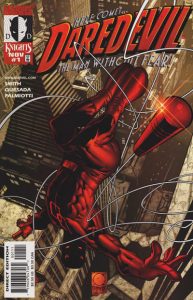
>> JOE QUESADA: It meant everything, and I’ll never forget the fateful meeting that Jimmy and I had with then President of Marvel, a gentleman by the name of Joey Calamari. We used to call him Joey Squid. And you could actually call him Joey Squid. It was cool. And Joe sat there and he said I don’t get it, how do you guys manage? You’re a three-person company. I can’t imagine you have any marketing budget. How do you get so much press? And in the back of our minds, we’re thinking about these insane parties that we would throw that were just fun for us, but people would come on down. I can’t tell you how often I’ve heard long after the fact, “that bar that you guys owned.” No, no. We didn’t own the bar. They just loved us at this bar. It was a great place. But we threw parties that you could not throw today. You just couldn’t do it.
>> BUDDY SCALERA: There’s too much photography today.
>> JOE QUESADA: We had, Nelson since you’re here I’m going to tell a great story. It was for your birthday. You’re taking the 5th. Just a little inside baseball, but we all loved Nelson and Nelson was part of that crew. Just to torture him on his birthday, we hired a mime. [laughter] And the mime was, to his strict orders, was to do everything that Nelson did. [laughter] So everywhere Nelson went in the bar, if he went to the bar and grabbed his drink, the mime would grab a drink, and he would just mimic Nelson the entire time. So, it infuriated Nelson for about the first hour and then after that he said screw it, now I’m going to screw with the mime. And then Nelson started to do really obscene stuff. He would go out into the streets and, I’ll let him tell that story off the record later, but it was those kinds of things.
We usually surrounded it around somebody’s birthday or a holiday or something. I think it was for Amanda Conner’s birthday, I mean again, this is a tavern with 9 foot ceilings, maybe 8 foot. It was low, right, and we hired a fire breather to come in. A poodle act, so it was poodles jumping through rings and it would get, and there were nuttier things that I just can’ even talk about.
>> BUDDY SCALERA: Not all of them.
>> JOE QUESADA: It’s not, there’s children in the audience. I can’t talk about. Oh, there’s the electric chair. We got the electric chair that Nelson, it was a big prop from a magic store called Abracadabra and we sat Nelson in the electric chair. He didn’t know that there was a dry cell battery attached to it. So, it was kind of like a carnival kind of atmosphere and it was a lot of fun and people, but we weren’t necessarily doing it as marketing. We were just doing it because it’s fun. It was a great art community, Marvel was right… so there were constantly artists coming in and out of town and they were all centered around there and then it turned out that we got marketing out of that and people just liked us, you guys don’t have money, but we’ll just do this for you, thanks for the good time, and you know, it was that kind of stuff.
>> BUDDY SCALERA: Yeah, and I remember then as Marvel Knights was coming up, it became Marvel Knights parties, right?
>> JOE QUESADA: Yeah. Marvel had no budget at all. So, as we would go to conventions, those Marvel Knight parties that we would throw like, you know, there’s a Marvel party tomorrow and there’s a convention party tonight. Marvel had no budget. So, we would throw the parties. We would say screw it. Out of our own pocket we’re just going to do this. Again, but that was just always the approach.
“Let’s go for the ride.”
>> BUDDY SCALERA: Now in a relatively short amount of time, I’m glad you brought that up, one of the reasons Marvel had no money was because, as you were there, Marvel was in chapter 11. So, chapter 11 is a bankruptcy designation where it’s protection from your creditors with the intent of coming out. A New York Times article said that Marvel’s stock had risen as you came on, 12.5 cents to a whopping $2.30. It’s documented. It’s very interesting to note that later Marvel was bought by Disney, and Disney’s stock is now $92.45 so it was a pretty dark time when you joined.
Take me to the time when you’re asked to come on, not as just a line editor, but to edit the whole ship. Talk to me about what’s happening in your mind. What are you thinking? What’s the internal monologue of I’m taking over a chapter 11 company as an editor?
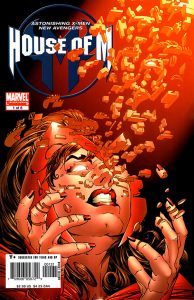
>> JOE QUESADA: Well when I got the offer, Bill Jemas pulled me aside, took me out to lunch and he made the offer. Everybody knew Marvel was in trouble. I didn’t know that this change, that they were going to change editor-in-chiefs and certainly if they were going to change editor-in-chiefs, I couldn’t imagine that they were going to hire somebody from the outside. So, when he broke the news to me, I said listen, I need the weekend to think about it because in my mind, there were two possibilities, right. You could be the last captain on the Titanic, didn’t want to be that. Or, you could have nowhere to go but up.
I remember speaking to my wife at that time and sort of vacillating as I do to make a decision and she said well look, they’re going to hire somebody anyway. Better the devil you know. I said I guess I don’t know anybody better than me. So, then I decided I’m going to take the job, but I’m only going to take the job with a list of stipulations, of things that have to become corporate initiatives and directives important to us for me to really excited to this, you know, things like we had no trade paperback programs. I mean we had zero trade paperback programs. DC was killing us in that area. Everyone was killing us in that area. So, when I sat with Bill and I read off the list, as it turned out he had a very similar list to me, so were thinking along the same lines.
At this point, it was like ok, let’s just give this a go. Let’s go for the ride. It took me a weekend to really sit and really sort of think about the decision and think about what was best for my career, for Event Comics, which was Marvel Knights, and everything else moving forward.
>> BUDDY SCALERA: What was, for you, the scariest part of this offer, and then the flip side of that, what was the most exciting part for you?
>> JOE QUESADA: Like I said, the only, I can’t say there was anything scary about it. What was actually scary at that time was that you just, the comic book industry, if you weren’t reading or selling comics at the time or publishing comics at the time it’s hard to sort of grasp this, but the comic book industry, and this started before we were offered the Marvel Knights gig, every month, and you were at Wizard so you saw this happen too.
Every month, sales were going lower and lower and lower and I remember being up at Marvel and some editor saying I think we’ve hit rock bottom. Then the next month, it’s lower. Now as an indie publisher, it was killing me too, because as Marvel goes, I really firmly believed so goes the industry, right? Sales were just dropping like a stone and retailers were going out of business left and right and as an industry we’re all just sitting there going holy mackerel, are we even going to be able to publish comics anymore? From an artist’s perspective, you’re sitting there going I don’t know what else to do. I’m going to have to go find a day job and learn another skill. That was just sort of the, I think that was an all-encompassing fear throughout the industry, like where is the bottom because once you hit bottom you can think about how you’re going to rebuild.
>> BUDDY SCALERA: Right.
>> JOE QUESADA: It just kept in a free fall. I think it started to stabilize a little bit sometime after Marvel Knights started. I’m not saying we were the reason it stabilized, but things started to get a little more stable and Marvel at least had a plan. So, I can’t say I was really afraid about anything other than just the industry. But with respect to what excited me, I mean what’s not be excited about? It’s like wow, ok, we came in and we asked for 4 characters and now I’m being allowed to destroy the childhoods of every fan.
>> BUDDY SCALERA: So I think it was interesting that you were very much where Stan Lee was in the 60s when he was thinking about leaving Marvel. Famous story about Stan Lee, he felt like he was a failure in comics and his wife famously said well if you’re leaving anyway, just do the comic you want to do and in 1961, he came out with Fantastic Four. That was what we would charitably call in our area a Hail Mary pass.
Do you have sort of the Hail Mary pass where you said I’m going to give this a shot, and in my mind, I’m thinking the first issue of Jessica Jones with the first major profanity in a Marvel comic. Was there a Hail Mary or something that you said I’m going to give this the best I’ve got and I’m going to give it a shot, because you did take some gambles early on. Not everything was…
>> JOE QUESADA: There was so many. When you look at those initial three, four, five years, everything was a gamble. Everything, it was the wild west, and I think the biggest one was the Ultimate Universe. That was the one that I think really turned things around. Nobody, if you can locate some of the fan press at that time, there was no idea, before it even came out the idea was more reviled than the idea of relaunching Spider-Man in this Ultimate Universe and retelling the origin. I mean it was just brutal and then the book came out and everybody knew it was going to be great. But that was a big one.
I mean it was, it was a big gamble for us to try to do this, but I think it paved the way for not only the cinematic universe but the tone of the regular Marvel universe moving forward and just showed what’s possible and what fans really, really want and can accept and how to revitalize these characters.
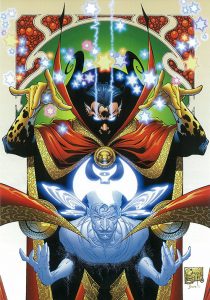
>> BUDDY SCALERA: Was, at that point, the Ultimate Universe the biggest gamble or was it introducing the first mature line at Marvel? What would you say was one on the bigger gambles for you?
>> JOE QUESADA: There were a lot them, I mean separating from the previous catalog, there was so many things that happened. It’s a mature line. It’s hard to say, and the other thing is, it’s a blur. There’s so much stuff that I tend, until you start talking about this to me, I really, I don’t spend a lot of time thinking backwards. I know that sounds weird, but I’ve just go so much on my plate moving forward, that I’m sure after this is done I’m going to go oh, that was the biggest gamble, you know? Maybe hiring Brian Bendis.
>> BUDDY SCALERA: That was a big gamble. Actually, it wasn’t an evident hire, either. If you guys remember, he was coming off of Goldfish then he did some Sam & Twitch and then you brought him on. He was not an heir apparent to take over a Spider-Man book. So, that you had, and I think it goes to you as a creator, you were not just someone who had drawn other people’s books. You’d written your own. How did that give you a sense of storytelling when you came into Marvel that maybe had even lost the, had frittered away in the entire industry? We were not in good times.
“It’s just a matter of learning your craft and continuously learning your craft.”
>> JOE QUESADA: Yeah, I think it’s just a matter of learning your craft and continuously learning your craft. As I delve even today into different mediums, right. I’m in the television world. I’ve never done television before this. I spend a lot of time asking questions and trying to learn the craft of television as best I can. But it was the same with comics. I lost track of the question. What was it again?
>> BUDDY SCALERA: Well your background as a creator and not just as an artist. You were the first major editor-in-chief as an illustrator who’s identified mostly as a penciler although you’ve done a ton of writing.
>> JOE QUESADA: So yeah, yeah. It has to do with learning a craft and I think knowing your craft, it helps you identify creators that know it as well. There’s, I forgot what the actually size of it is, but there’s a theorem that obviously in order to do a job incredibly well, you have to master how to do that job. In order to know that a job is done poorly, you also have to be a master of the job because then you really don’t know, right? Or you’re kind of too dumb to know that you’re dumb at something, right?
>> BUDDY SCALERA: That’s the Dunning-Kruger effect. People are too stupid to know that they’re stupid.
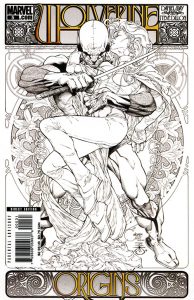
>> JOE QUESADA: See, you’re so smart! So again, I really pride myself as best as possible to, you know I didn’t start as a writer, but I went out there and tried to learn as much about writing as I possibly can because I can certainly never write as well as Brian can, but I’m able to identify I think somebody who’s like oh, this is a guy that could really, really cut it in our business. And you know, you never really write 100% of the time, but if you write more often than not, then you can run a really successful publishing business.
For me it all started with the writing. That was the other thing. As much as I started on the artist side of things, as an artist I did not want to draw stories that were not well written. There’s no worse fate in life than to draw a crappy story, that’s a crappily written story. So, I always gravitated toward strong writing and felt that if you have strong writing, everything else will follow. You’ll get great artists.
>> BUDDY SCALERA: There was a buzz amongst us journalists and/or fan press that you were going to make image New York City, right, because you were coming as an artist and yet you turned Marvel to be much more writer focused and it seemed to turn the tide in the right direction to where we are today.
>> JOE QUESADA: It was everything. It was really, really everything because I know there’s an argument as to what sells a comic, great art or great story? Back during the collector’s boom, right, when everybody got rich, it was all about the art. Nobody cared about the story because 70% of those books were never read and they were never taken out of the plastic bag. It was all about who was the artist and by the way, that did form, that did great for the image guys. They were at the right place at the right time, excellent art, great energy.
As for rebuilding a business, that’s not what’s going to sell books. What’s going to sell books are engaging stories that when you get to the last page, you’re like “damn it, I’ve got to pick up the next one.”
If we could do that, I would argue that at that time, you could build a tremendous business without superstar artists. You could build a tremendous business with guys who are solid, great storytellers as long as you have incredible writers behind it. But I think that proved to be really, really true and even to this day.
Even right now everybody talks about if we’re going to improve our publishing business, we have to make our stories better, we have to get down to the core of our characters. That’s the way we operate. That day of the superstar artist, while there are artists that do drive the business somewhat, it’s nothing compared to those days where you could put superstar artist number two on a book, number three on another book, and it’s guaranteed to sell. And literally there could be no words in that book.
>> BUDDY SCALERA: Taking a sip of my Red Bull.
>> JOE QUESADA: Are we sponsored by Red Bull?
>> BUDDY SCALERA: We’re sponsored, in the back. Where are the Red Bull girls? Where’s my Wings team? Yeah, they’re giving out free Red Bull so [inaudible crosstalk]…
>> JOE QUESADA: In that case, I need to get another one.
>> BUDDY SCALERA: You need another Red Bull? I have a couple more of these.
>> JOE QUESADA: Anybody out there want a Red Bull?
>> BUDDY SCALERA: I said that more comics have shipped on time thanks to Red Bull probably than any other liquid in history. You said something earlier, and I think I want to, I want to note that we didn’t work any of this out in advance. He didn’t give me any requirements or questions…
>> JOE QUESADA: He forgot to give me his phone number.
>> BUDDY SCALERA: …that he can or cannot answer. You used the word “reviled” and I think it’s a very charged word and I know that outwardly you have to have a face for Marvel, but I know inwardly, and I know that you’re a sensitive person and you’re thoughtful. What does it feel like when fan anger is pointed to you? What is that like, I mean you’re not just an average creator that had a crappy issue. You get a lot thrown at you. What’s that like?
“Fandom has been very, very quiet. Let’s stir it up a little bit.”
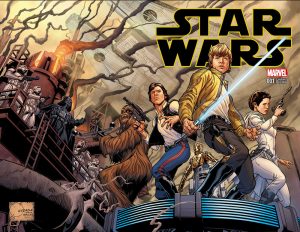
>> JOE QUESADA: I remember a day, I was at the job of editor-in-chief. It’s one thing when you get it as a creator, right? It’s nothing to compared to when you’re getting it for everything and you’re editor-in-chief. I remember Tom DeFalco came into my office. I was at the job for about a week. He came into my office. Now Tom had been the editor-in-chief of, there was Bob Harras who was the editor-in-chief prior to me, but Tom was prior to him. And he came in and he said, can I give you one piece of unsolicited advice? I’m like give me as much as you want. And he said, “to do this job, you have to have a broad back. If you don’t have a broad back, Joe, quit right now, I’m telling you. It’s not going to be healthy for you.” And I’m like, “I got it.” You know, I got it. I accepted, it becomes, because I know it’s not personal.
Even when people say “Joe hates, you know, the X-Men,” “Joe hates Spider-Man.” Look c’mon, I do not. And I know that. right, so I don’t take it seriously because I’ve often said on the internet, or just in fandom in general, fans treat our characters like they’re three-dimensional living, walking human beings who could live and walk through the door right now, but they treat creators, editors, everyone else as if they are two-dimensional comic book characters, in some case twirling a mustache. But you know what, that’s actually cool. That’s actually ok because it just means we’re doing a really good job of making those two-dimensional characters real. But I fully accept it, absolutely.
It gets a little crazy when it’s completely unwarranted and it’s based on fabricated rumors that are out there. That gets frustrating, but ultimately I knew that came with the job. Absolutely came with the job, so I don’t take any of it personally. You know the stuff that really keeps me up at night is if I know a creator is unhappy, or a friend is unhappy. That’s the stuff that really bothers me because that affects me and my world and sort of my worldview of how to do business and how to treat people. But I don’t, and look, when I started as editor-in-chief, the first thing I said was I’m going to use this to my best interest.
Fandom has been very, very quiet. Let’s stir it up a little bit. And I kind of created this wrestling persona to just kind of go out there and just say things and a lot of it was very calculated just to get Marvel fans riled up, but it was more important to get DC fans riled up. Because I loved that rivalry.
I loved the idea that there’s Marvel fans and there’s DC fans and they’re some people in between but they’re like we’re better, no we’re better. That’s so healthy, I think, for comics in a lot of ways because it drives units and it gets people talking about their characters and why a certain writer is better than another writer, why a certain character is stronger than another. That’s what comics is about, so I was happy to maybe stir that pot a little bit. Some of it was intentional, and brought on by my own stupidity in a lot of ways.
>> BUDDY SCALERA: Now I would imagine that this is part of your upbringing in the New York area, to be a little bit tough, to stir things up a little bit. How does this play internationally and globally? The personality here, every gets the jokes. You go sometimes to different places and they just – they’re not getting it. Do you have to make shifts for that?
>> JOE QUESADA: Depends on where you go. It really depends on where you go, but I think a lot of people get it, or if they don’t, I’ve had a lot of people meet me personally and go, “oh you’re really not an asshole, are you?” No, no, no. “I just play one on the internet.” [laughter] It’s, it hasn’t been an issue in that sense.
“I post a lot of this stuff to try to help demystify that process and to show some of the magic tricks that happen behind the scenes.”
>> BUDDY SCALERA: Let’s go back to something you said earlier about your tool box. I noticed, at least in your photos that you’ve posted online, that you started to shift from straight pencil and paper on to a Wacom. Why would somebody like you go and experiment with this new medium? You’re a master of the page. Why would you start to experiment there? Do you see this as the new direction that many creators… because a lot of people that are here are here for, because they’re aspiring creators. Can you talk a little about that?
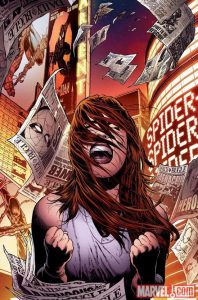
>> JOE QUESADA: Yeah, I mean love adopting, look I studied, I didn’t go to college. I went to arts school. I didn’t go there to be a comic artist. That wasn’t my major. My major was illustration.
I actually took two comic book courses and failed them both. I kid you not. I failed Will Eisner‘s and I failed Harvey Kurtzman’s class. Just because I didn’t hand in my final project. I just wasn’t interested in doing comics at the time. But as a professional illustrator, or aspiring professional illustrator, hey man, whatever makes the work better, whatever makes the work faster, or allows you to use certain techniques that you can’t do physically, or new techniques that come in, I want to try whatever works and I started experimenting with digital and I found that it allows me to do certain things either faster, or if it doesn’t allow me to do it faster, it allows me to do it more accurately than I normally could.
Again, I think my job as an artist is to provide the best art I’m physically able to provide to my client, and hopefully within the deadline that they aspire to have it, in the best way I can and if that means using digital or it means using analog or whatever it takes, it’s going to get used, you know. And I also don’t want to be caught behind the curve where I’m not in tune to what all other artists are starting to learn.
I have a fifteen-year old daughter and she’s doing some stuff on paper, but she loves drawing on digital as well. It is the way of the future. The only comics today are behind the digital curve, because they are behind the digital curve when it comes to animation and professional and everything else because there is an original art market. If that original art market did not exist, I could see more and more artists saying “screw it, I’m going digital.” I’m talking about young artists. Because there are older artists that are like it’s just what I do and I don’t want to learn anything new. That’s cool but that’s the only reason why comic book artists still do analog art.
>> BUDDY SCALERA: What are you doing for your personal experimentation and learning on this platform? Obviously the first thing I saw you doing is your mastering your line work. And you were posting it and it’s a very interesting stream to watch or follow, I think mostly on Twitter, I’m following it.
>> JOE QUESADA: Yeah, I post it everywhere, you know.
>> BUDDY SCALERA: But what are you doing, so are you trying new techniques, are you getting the latest and greatest? How are you approaching…?
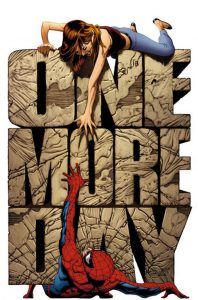
>> JOE QUESADA: I never used to ink my own work and now I’m able to ink my own work. Just because I don’t have, I never learned and I didn’t have the patience to sit there and really try to learn how to steady my hand and how to handle a brush. You know what, they’re going to hire an inker. Let the inker do it. Jimmy’s going to ink it. Hey, that’s great. So, it’s allowed me to actually be able to ink with a tool that feels comfortable.
It’s allowed me to go back to painting which I haven’t done. Yes, I do a lot of stuff, personal stuff for myself. So, it’s allowed me to go back to painting without having to invest in a whole set of paints and everything else that I would need to do it. It’s just all there in one place. But also part of the reason I like to put this stuff out there, and I learned this from having a child, my daughter, what I want to try to do, especially for young artists who are following, is to try to demystify the process of art, right?
Perfect example I’ll give you, where it sort of hit home was I remember my daughter trying, she was sitting next to me at an art table and she was trying to draw what I was drawing and getting really, really frustrated and then walking away in anger. I’m like, “what’s the issue?” And she says, “I can’t do it like you do it.” And I’m like, “I’ve been doing this since you were that small, right? And I didn’t draw anywhere near as well you do…” but it was hard for her to grasp it.
And then I immediately remembered thinking about my own childhood and as I was trying to copy something from another artist and not being able to get it and getting frustrated, but eventually working through it and realized you know what, I bet a lot of young artists see pros, why can’t I do it? Why can’t I get that line?
So, I try to demystify that process as much as possible and say, “no, no you know what? A lot of this stuff is also done with tricks and mirrors and 3D models and all the stuff that’s out there. It’s ok to use it.” There’s no sin in it because, as a lot of professional artists can attest, we would hear stories sometimes about “hey did you know that this one particular genius artist can start drawing on a left-hand corner and finish an entire comic in one fell swoop” and we would go “wow, really” and then you’d realize that’s complete and utter bullshit. It’s not at all how it happens.
But you hear a lot of these myths about how certain people are just able to just do it and then without really knowing all the work, and then I realize a lot of it also comes from the fact that people don’t see the behind the scenes stuff, right. I just finished, literally, about 10 minutes ago I finally finished a Star Wars cover that I’ve been working like an hour at a time on. People will see the final product and go “oh, that’s good” or “it sucks,” one or the other, but what they don’t see is that now, well it’s digital waste basket.
I have a digital wastebasket of as many 30 or 40 rejected sketches or rejected anatomical turns or twists to a particular arm or to a shoulder. It took me an hour just to work out this one shoulder position, just to get that one image. They’ll see the final image and go, artists will go “why can’t I get that” because that’s the way I was and I think most artists are.
So, I post a lot of this stuff to try to help demystify that process and to show some of the magic tricks that happen behind the scenes. I even had an artist once that got pissed off at me for showing, said why are you showing them that? Because people need to learn this stuff. It’s cool, it’s alright.
If it gets one kid past the point of frustration where they go “oh ok, it’s ok to screw up. It’s ok to throw this piece of paper away,” which again, I have to go through with my daughter. If it’s no good, just throw it out. Start again, right? Until you get it right. It’s the only way you’re going to get it right. If I can help some artists, with adults it takes too long. If one kid just continues going, that’s kind of cool.
>> BUDDY SCALERA: And what do you want to accomplish as a creator? Forget the publishing thing. Forget the creative director. What do you want to accomplish as a creator that you’re still pushing to get to?
>> JOE QUESADA: Complete and utter world domination. [laughter] No, you know what, I just want to do good work. I have a couple of things that are on my wish list of things that I want to do. One in particular, and I’m actually going to get to achieve it but I can’t say what it is here because I can’t announce it. But there was one thing that’s been on my wish list for a very long time, even before I was at Marvel. Yeah, so that’s one off the bucket list that, something that I really wanted to do. And that’s do it once. It’s something that I, a skill that I’ve been sort of building up to.
>> BUDDY SCALERA: What’s something else that’s on your bucket list that you feel like aspirationally that you still need to accomplish?
>> JOE QUESADA: I have a book that I’m writing and drawing. Again, it’s all been piecemeal. I’ve been working on this now for five years, maybe six years and it’s not a superhero story. It is sequential and it’s really more of like a kid’s fantasy tale, so it’s sort of an all ages thing, and it’s funny, it’s actually drawn in my real style. People see my superhero stuff. My real style is really cartoony. It’s very, very cartoony. So, it’s actually drawn, this is just like totally unmasked, “this is me, here it is” and eventually I’ll finish it and get it out there. I’ve got it pretty much all written, because I don’t draw until it’s all written. That’s one that I’m anxious to one day be able to sit down, I keep saying yeah, I’ll have some time to work on it next week because I have a little opening in my schedule and that means it will go [sound effect] close down and I’ve got no time, but I do hope to finish that someday.
“You have to master your craft, and you cannot do that unless you do it, right? Writers have to write, artists have to draw. “
>> BUDDY SCALERA: Now one standard piece of advice as we’re running out of time here, one standard piece of advice. Many of these people who are aspiring creators have come here with the hopes of seeing you, maybe connecting with you. What advice could you give to the aspiring either writer or artist who is coming here with the hopes of seeing Joe Quesada, maybe getting that elevator moment with you. What advice could you give the people who are here and maybe some travel pretty far to get here?
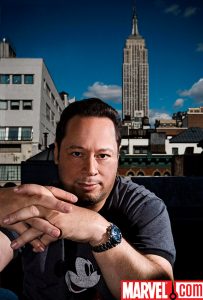 >> JOE QUESADA: There’s more, it’s obviously hard to distill it down into one piece of advice, but really it all comes down to mastery. It really does. You have to, whatever your chosen discipline is, whether you want to write, whether you want to draw, whether you want to color, you have to master your craft, and you cannot do that unless you do it, right? Writers have to write, artists have to draw. I’ll break it down into hopefully a simple metaphor. I love baseball. Love baseball. Wanted to be a professional baseball player all my life.
>> JOE QUESADA: There’s more, it’s obviously hard to distill it down into one piece of advice, but really it all comes down to mastery. It really does. You have to, whatever your chosen discipline is, whether you want to write, whether you want to draw, whether you want to color, you have to master your craft, and you cannot do that unless you do it, right? Writers have to write, artists have to draw. I’ll break it down into hopefully a simple metaphor. I love baseball. Love baseball. Wanted to be a professional baseball player all my life.
I’ll break it down even more personally. My daughter is a figure skater. Loves it with all her life. She’s up at 4:30 every morning. She goes to the rink she skates all morning long and then goes to school, does her homework, comes home, sometimes she skates at night. Every day, six days a week, in the summertime, she skates eight hours a day. That’s what she wants to do, right?
So, if you want to be a professional baseball player, an Olympic skater, whatever it may be, you have to practice every day. You have to be in the batting cages every day. You have to field ground balls every day. It’s the same thing with art. You cannot just assume that it just happens, it doesn’t happen because you don’t feel inspired today.
I don’t care if you’re not inspired today. Pick up a pencil and draw something.
I don’t care if you’re not inspired as a writer today, you’re not feeling it. Get behind the keyboard and write something. Especially on the days you’re not feeling it. That’s where it really happens. That’s where you really have to push through, and then in contrast to that, you also have to be forgiving of yourself and you have to understand that some days it’s just not going to happen and you’re not going to be at your best and the drawing is not going to rock, and the writing is not going to rock.
So you’re in a slump, but you have to keep plowing through. You have to grind it out. It’s the only way you’re going to become, if you want to be a professional, if you want to just do it as a hobby it’s a whole other thing, but if you want to be a professional it’s the only way it’s going to happen. Whether it’s indie, Marvel, DC, anybody.
>> BUDDY SCALERA: Can you think of… [spontaneous applause] Was there ever a time that you, during your ascent, coming out of ’93 when you came in on Ninjak, through the years you just thought, I’m done, throwing in the towel. Was there ever a dark time for you that you just felt like I’m gonna go do something else?
>> JOE QUESADA: No.
>> BUDDY SCALERA: And what was it that grounded you, that said, a lot of people think about throwing it, why did you never think about quitting?
>> JOE QUESADA: I just, I was surrounded by good people, right? I had like minded and I never had any doubt about the fact that I was going to make it in the industry. And I also, this is something that Jimmy and I had agreed on, one of the key decision that we had made was we had both worked on Ninjak and Valiant and we had a relationship with Valiant. That sort of fell apart. That was the impetus for us to start Event Comics. I had been offered, prior to that, to be a second wave image guy, like what (Greg) Capullo and Jimmy and those guys were, they were the second wave guys. And they made a ton of money.
I had been offered to be part of that wave, and Jimmy and I discussed this and you know, I’m not going to do it because at the end of the day I will always be known as Jim (Lee)’s guy or Todd (McFarlane)’s guy or you know, and even though, this is no slight to Greg and those guys. They did really, really well for themselves, but I, we talked about it, let’s carve our own path. Let’s just do it.
So, we started an independent company in the worst time in history of comics to start a company. but we did ok. We did ok as a three-person company with a few books and a few characters, I think those kinds of decisions that we’ve both done during our lifetime. And a lot of successful creators, when you ask them about these decisions, it’s a clear path right here. I could make a lot of money. Some people take that path and it’s great and it works for them and for others, it’s like you know what, I’m going to try this way. It’s that old adage, the most successful people on the planet have failed more than you or I ever attempted to do anything because it’s the only way.
Nobody hits a home run the first time out. You just have to take your chances and try to take the path that works for you. The path that worked for me at that time was the one less traveled and a little riskier, but it was a belief in myself, Jimmy’s belief in himself, and it kind of worked out.
>> BUDDY SCALERA: It kind of worked out, yeah, kind of worked out ok for you. So, looking into your crystal ball, where are you in ten years?
>> JOE QUESADA: Oh man, I don’t know. I honestly don’t know. Those early days at Marvel, I used to, you could probably find this on the internet, I would say I’m so tired of comics being in this sort of creative ghetto in the art world, right? People would look at comics like it’s a crappy arts medium, it’s not real art. The hope was to someday be able to have great movies and have it be considered great literature which I think we’re at that point today. I don’t know. All I know is that I want to, I want to continue telling stories in some way, shape or form.
One of the things I love about being chief creative officer, the difficult part with it is that I don’t, I get to work with a lot of other people’s creative stuff, and I get to contribute to a lot of the stuff that we’re doing as a group creatively, but there’s very little that I’m doing that is pure just me, this is just my stuff, you know? That’s why I’m working on that kid’s book. It sort of helps keep that side of the brain sane.
So, I’m thinking that maybe in 10 years I’ll be doing something that’s a little more, I’m not saying it won’t be for Marvel, I’m just saying it would be a little more personal, at least sort of more me than me working with somebody on another project. So, we’ll see. We’ll see what happens. It’s, right now I’ve got so much on my plate it’s hard to really think beyond, what time is it?? [laughs] Yeah.
“I don’t know where my life would be if I hadn’t have read those original comics.”
>> BUDDY SCALERA: So we have time for one more question, and the question is, you know, we look back at, we say Jack and Stan, right. We name them first name because their work is so intimate to us and they have left a long path and a legacy and there are people recording this today, recording every word that you say and there’s is a rich fandom out there, and they’re recording things. What do you want people to know about you and the legacy that you leave 25 years in the future, long after you’re not active every day?
>> JOE QUESADA: Oh man, you’re, that requires me thinking a lot more about myself than I, time that I would ever spend. I guess I’ll say the same thing that I said when I started as editor-in-chief, my sole goal is that when it’s all said and done, at least my Marvel tenure, whether it’s editor-in-chief or chief creative officer, my sole goal is to hopefully leave the characters in as good a shape as they were in when I found them, and hopefully maybe better. If I could do that, if I could do that, then that’s cool because that’s the job, right? That’s the job.
As much as we spin these characters’ lives and un-marry Peter Parker and whatever you want to blame me for, right, which by the way, was the right thing to do. [laughter]
At the end of the day, I hope that we look back and go, yeah these characters are, they’re still here, right, and they’re still kind of cool and relevant, so as far as my Marvel career, that’s what I would hope.
As far my personal career, I just want them to say you know, he spun a good story. He told a good yarn, whether it was drawing, writing, or even just talking at a panel. That seems to be all I’ve been doing my entire life, just sort of talking and keeping people engaged at something or other, and maybe sparked an imagination here too because when I look at somebody like Stan Lee, when I look at somebody like Jack Kirby, those guys, and I told Stan this. I saw him in Toronto at this panel and I hugged him and I said to him, “you saved my life” because, and I say that in a really broad term, it’s not like I was suicidal and I read Fantastic Four and I was like oh my god, I’m not going to hang myself today, no.
I don’t know where my life would be if I hadn’t have read those original comics. I don’t know if I would have understood that there was a road for a kid who spent his days, I was an only child, who spent his days in a room making up fantasy stories about sword fights and space ships and stuff like that. I wouldn’t have known there was a road for that and reading Stan and reading Jack and Steve and all those guys, I said “oh wow, there’s a place where people are doing this for a living, and it’s kind of cool.” So, if there’s a kid out there who someday says “yeah, you know I read that and it gave me a spark,” that’s enough for me, you know, so…
>> BUDDY SCALERA: I can’t think of a better place to stop and say thank you to Joe Quesada for his generous time. [applause] Thank you all for coming. We’re going to take Joe, hustle him off to the stage, get a couple of photos. I’m sure you guys will want to have a couple of photos of Joe as well. Thank you so much Joe for being here.
>> JOE QUESADA: It’s my pleasure.
>> BUDDY SCALERA: We really appreciate it. One more round of applause for Joe Quesada everybody.
>> JOE QUESADA: [applause] Thank you.
Additional Links:
Photos from New York Comicon 2016
BN.com: The Marvel Art of Joe Quesada
Amazon: The Marvel Art of Joe Quesada
Creating Comics from Start to Finish Book
Marvel.com: Joe Quesada comics
Joe Quesada On His Career, Unmarrying Spider-Man And His Plans For World Domination
NYCC: MARVEL’S QUESADA TALKS TURNING PARTIES INTO FREE PRESS
Marvel.com: Buddy Scalera comics
Adrian Has Issues: Episode 73: Comic Book School Presents – Creator Studio With Joe Quesada
Breaking In: Comic Publisher Submission Guidelines
Paying The Bills:


